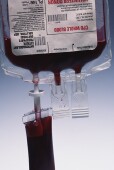
THURSDAY, May 30 (HealthDay News) — Patients who receive a red blood cell transfusion during or after heart surgery may be at greater risk for infection, according to a new study.
However, the use of platelets during transfusions does not appear to carry a similar risk. Limiting red blood cell use could result in fewer major postoperative infections, the researchers suggested.
The study is published in the June issue of the Annals of Thoracic Surgery.
“A common problem for many surgeons, and thereby the patient, is how to balance the risk of surgery-induced anemia with the increased risk of infection when using red blood cell transfusion to correct the anemia,” study author Dr. Keith Horvath, at the U.S. National Heart, Lung, and Blood Institute, said in a journal news release.
“Through this study, we hoped to shed light on the problem and to encourage hospitals and surgeons to examine cell-salvage techniques and other alternatives to [red blood cell] transfusion during and after cardiac surgery,” he explained.
The observational study, conducted by the Cardiothoracic Surgical Trials Network, involved nearly 5,200 adults who underwent heart surgery between February and September 2010.
“Our study enrolled a large population of patients from a number of different institutions who were undergoing any type of cardiac surgery,” Horvath noted. “This large patient set enabled us to better examine the relationship between transfusion and infection in a very diverse population.”
Of the study’s participants, 48 percent received a red blood cell transfusion and 31 percent received platelets.
With red blood cell transfusions, 84 percent took place during a transplant or left ventricular assist device implantation. Meanwhile, 63 percent occurred during thoracic aortic procedures, 45 percent took place during isolated coronary artery bypass grafting surgery and 40 percent occurred during isolated valve surgery.
The study found that 65 days after surgery, 5 percent of the patients developed at least one major infection, such as pneumonia, C. difficile colitis (a bacterial infection in the colon) and bloodstream infections.
With each red blood cell unit transfused, there was a 29 percent increase in infection risk. In contrast, platelets transfused along with more than four unit of red blood cells was associated with a lower infection risk.
“Few in regulatory agencies have grasped the complex but real relationships between red cell transfusions, infection and … readmissions,” Dr. Bruce Spiess, from Virginia Commonwealth University Medical Center, wrote in a related journal commentary.
Spiess concluded that improvements in blood management among cardiac teams would enhance patient safety, reduce hospital-acquired infections and reduce critical blood shortages.
However, the researchers pointed out that since this was an observational study, the reported associations cannot be considered as a cause-and-effect relationship.
More information
The U.S. National Marrow Donor Program provides more information on red blood cell and platelet transfusions.

